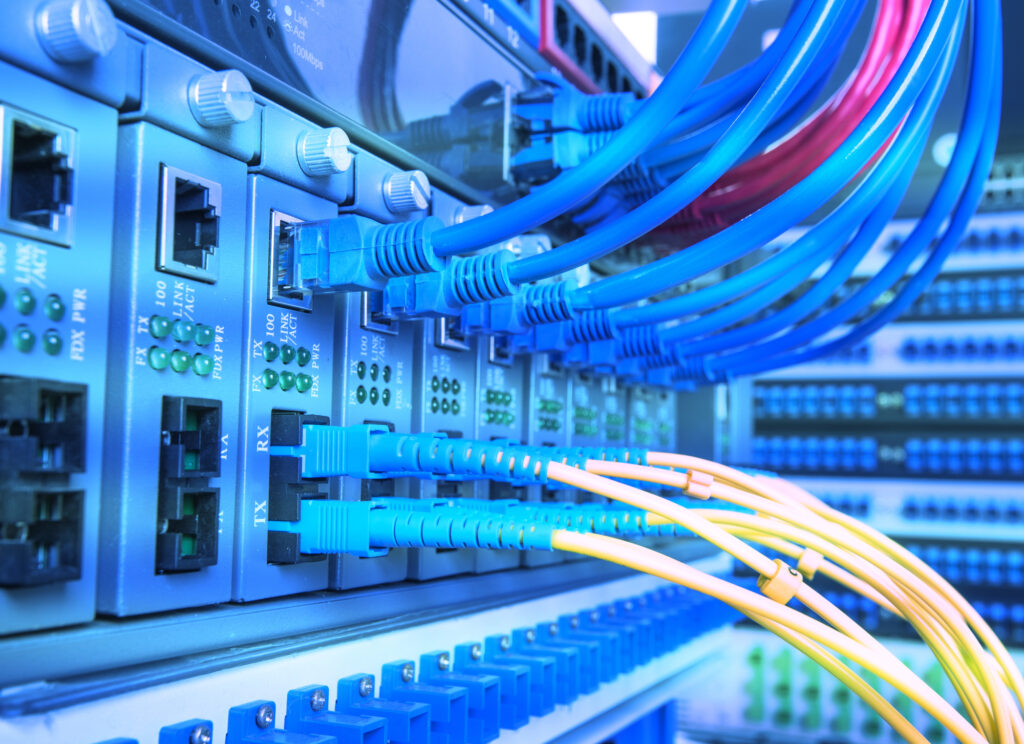Reliable network infrastructure has become the backbone of modern offices. As businesses increasingly rely on cloud-based applications, video conferencing, and smart technologies, the need for fast, dependable, and high-bandwidth connectivity has never been greater. Enter fiber optic cables — a revolutionary solution that’s leveling up business networks everywhere.
For companies ready to future-proof their infrastructure, fiber optics is the technology to watch. And when it comes to fiber optic installations, ADD Communications stands out as a trusted partner, offering tailored solutions to meet the demands of today’s businesses. Want to discuss your networking needs? Give us a call at 336-252-4897.
What Is Fiber Optic Cabling?
Fiber optic cabling is a cutting-edge technology that transmits data using light instead of electricity. Here’s how it works and what makes it unique:
- Core Components:
- Core: The central part of the cable that contains glass or plastic fibers where light travels.
- Cladding: Surrounds the core and keeps the light signals contained.
- Protective Coating: Adds durability and protects against environmental damage.
- Single-Mode vs. Multi-Mode Fiber:
- Single-mode fiber uses a single light path, making it ideal for long-distance data transmission.
- Multi-mode fiber supports multiple light paths and excels in shorter-distance connections.
Because it uses light to transmit data, fiber delivers faster speeds and greater capacity compared to traditional copper cabling.
Current Challenges with Traditional Copper Cabling
While copper cabling has been widely used for decades, its limitations are becoming increasingly evident in today’s digital landscape:
- Limited Bandwidth and Slower Speeds:
Copper cables struggle to handle the ever-increasing data demands, especially over long distances.
- Electromagnetic Interference (EMI):
Copper cables are highly susceptible to network disruptions caused by EMI, leading to slower performance.
- Bulk and Weight:
Copper cable installations are bulkier and heavier, posing challenges for large-scale deployments.
- Signal Degradation:
The further the data needs to travel, the more copper signals weaken, necessitating costly signal boosters.
Key Advantages of Fiber Optic Cabling
Fiber optics eliminate the issues associated with copper cabling and offer several compelling benefits:
- Speed and Bandwidth
Fiber optics support multi-gigabit speeds and can accommodate heavy data loads, making them ideal for demanding applications like video conferencing and cloud computing.
- Long-Distance Transmission
Unlike copper, fiber optics experience minimal signal loss over long distances, ensuring consistent performance in large office buildings or campuses.
- Enhanced Security
Fiber optic cables are difficult to tap into without detection, offering superior data security for enterprises handling sensitive information.
- Durability and Longevity
Resistant to environmental factors such as temperature fluctuations and moisture, fiber optics provide a better long-term return on investment (ROI).
- Scalability
Fiber-ready networks can seamlessly accommodate emerging technologies like 5G, IoT devices, and AI-driven analytics, ensuring your business stays ahead of the curve.
Trends Driving the Shift to Fiber in Commercial Spaces
Several key trends are accelerating the adoption of fiber optic networks in commercial settings:
- Cloud-Based Applications
Tools like Microsoft 365, Zoom, and Salesforce demand robust internet infrastructure to ensure reliable performance.
- Hybrid and Remote Work
With employees working from multiple locations, enterprises require high-performing networks to support real-time collaborations.
- Smart Buildings
From automated lighting to energy-efficient HVAC systems, smart buildings depend on fiber optic infrastructure to connect sensors and devices.
- Video Conferencing Demand
The need for seamless communication tools to connect dispersed teams necessitates high-speed, low-latency networking solutions.
Considerations Before Making the Switch
Switching to fiber optics comes with many upsides, but it also requires careful planning and investment. Here’s what businesses should consider:
- Upfront Costs vs. Long-Term Savings
Fiber installations may have higher initial costs, but the minimal maintenance and longer lifespan result in significant long-term savings.
- Existing Infrastructure Compatibility
Media converters can help businesses integrate fiber with legacy systems during the transition.
- Professional Installation
Fiber optic installations require skilled technicians and advanced certifications to ensure precision and compliance.
- Maintenance and Testing
Proactive network monitoring and routine testing can help maintain optimal performance over time.
Why Choose ADD Communications for Your Fiber Optic Installation?
When it comes to commercial fiber optic cabling, ADD Communications provides end-to-end solutions designed to meet your unique business needs. Here’s why businesses trust us:
- Proven Expertise
With over 20 years of experience, we specialize in structured cabling, fiber optics, and low-voltage solutions.
- Certified Technicians
Our team of trained and certified professionals adheres to the latest standards and best practices.
- Custom Solutions
We provide scalable designs tailored to your office size, layout, and future growth plans.
- End-to-End Service
From site surveys and network design to installation, testing, and certification, we’ve got your fiber optic project covered.
- Reliable Support
We offer ongoing maintenance and troubleshooting to ensure your network operates smoothly.
- Trusted by Industry Leaders
Our client portfolio spans corporate offices, educational institutions, healthcare facilities, and industrial complexes.
Fiber Optics Are More Than the Future; They’re the New Standard
As businesses increasingly depend on high-speed internet to remain competitive, fiber optics have become the gold standard for office connectivity. They’re not just a luxury but a necessity for forward-thinking organizations.
If your business is still relying on traditional copper cabling, now might be the time to evaluate your network infrastructure. Investing in fiber optics can position your organization to thrive in an increasingly connected world.
Contact ADD Communications today at 336-252-4897 for a free assessment and discover how we can help you integrate fiber optic technology into your business operations. Future-proof your network with expertise you can trust.
